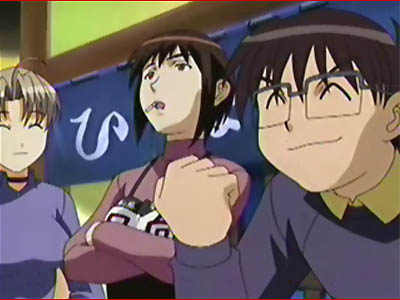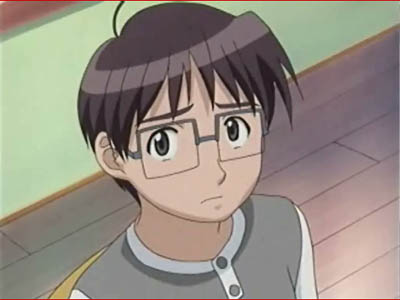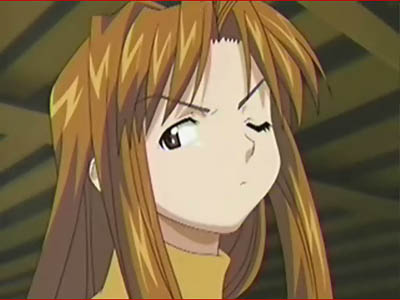25 July 2002: Love Hina
I have heard good things about Love Hina for years. The buzz for both the manga and the anime was uniformly good enough that I kept it on the radar and made an effort to avoid spoilers. Now that I've finally seen the anime, I am happy to say that as much as Serial Experiments Lain disappointed me earlier, the brilliance of Love Hina exceeded my wildest expectations.

Kitsune, Haruka, and Keitaro
By no means will a short synopsis do Love Hina justice. Even though the show makes no attempt to be grandly philosophical, complicated, or pseudo-intellectually dramatic (*cough* Lain *cough*), it is far too rich to deserve a mere description.

Keitaro
Love Hina is a slapstick comedy about the life of hapless Urashima Keitaro, a young man who has failed the entrance examination to Tokyo University three times. He is determined to pass because he made a promise with his childhood sweetheart to join her there when they grew up. However, the fact that he can't remember her name or her face complicates the matter somewhat.
Keitaro's grandmother is the manager of the family's inn which is being used as an all-female dormitory for a handful of teenage girls. When she decides to retire and travel abroad, she names Keitaro as her successor, leaving him to take care of the inn, its hot springs bath, and its comely residents. Rampant hilarity ensues.
Although Keitaro is ostensibly the main protagonist, the focal point of the show is actually Narusegawa Naru, one of the girls living in the dorm. An engaging (if tempestuous) lass, she initially serves as Keitaro's counterpart and primary love interest.
Rounding out the cast are the painfully earnest Maehara Shinobu, the skillful and stern Aoyama Motoko, Naru's best friend Konno "Kitsune" Mitsune, Kaolla Su the wild child, Keitaro's chain-smoking aunt Urashima Haruka (perfectly voiced by a very droll Megumi Hayashibara in a small role), and the ditsy Otohime Mutsumi. Joining this cast is a motley crew that grows quite rapidly, although it never becomes so large as to dilute the quality of the show.

Naru
Naru begins the series as an instrument for developing Keitaro's character, but as the series advances, Naru becomes the show's anchor. She is Naru the dedicated student, Naru the hot-blooded bitch, Naru the unwitting sex-bomb, Naru the emotionally vulnerable girl, and Naru the klutz (although in all fairness just about everyone on the show, particularly Keitaro, is a klutz due to the unreliable vagaries of Anime Gravity). She is also Naru, Keitaro's dramatic foil, and during the course of the series, this role becomes Naru, Keitaro's partner. A great deal of the show's appeal lies in watching Naru's open hostility towards Keitaro metamorphose into quiet affection. Even Naru's outbursts of violence seem to change from being a way of expressing frustration and anger into a means of demonstrating love.
Love Hina is successful largely because of its remarkable chemistry. Thematically, the anime is a perfect blend of emotional resonance occasionally punctuated with giant robots. Love Hina is almost entirely driven by the intensely repressed characters' inability to express their feelings openly. In this way, Love Hina is much like Ah! My Goddess. However, Love Hina doesn't take itself as seriously. Not that Ah! My Goddess is an animated version of Sophie's Choice or anything, but Love Hina is more intent on showcasing its impeccable comedic timing than anything else.
Here, the show succeeds wildly. Physical comedy is an underrated talent very difficult to pull off well. (For example, although Denzel Washington may be a good actor, I doubt he could sell a pratfall even half as well as Jackie Gleason could.) Simple gags like Naru smacking Keitaro with a wild haymaker that knocks him end-over-end through a swinging door are executed beautifully. A large hole in the floor connecting Naru's bedroom with Keitaro's, below, is also used to great effect. There are also numerous sight gags to be found throughout the series, too good to spoil.
This is not to say that Love Hina is not melodramatic at times. Another strength of the show is that it stays true to the spirit of romance with all its whimsical ups and downs—romance as explained by O. Henry in The Green Door, is courage in the face of fear and the unknown—a friend to quiet sadness rather than a vessel for songbirds and flower petals. The primary element of romance is hope, not happiness.
Alas, nothing good ever lasts, and Love Hina's 24 episodes end far too quickly. Thankfully, later installments including a Christmas Special, a Mokoto-driven "episode 25," and a Spring Special continue the saga without wearing out the show's welcome. Together they wrap up the series and exemplify the maxim that it is better to go out too soon and on top than too late; it's better to retire like Joe DiMaggio than Willie Mays.
Love Hina Again, a three-episode OAV, attempts to continue the story (picking up after the Spring Special), but fails to capture the magic of the original series. Although the characters remain true, the tone of this sequel sharply contrasts with that of the original. Love Hina Again is dark and often humorless whereas the earlier installments were always funny and occasionally optimistic despite the characters' frequent frustration and palatable anxiety. From a clinical standpoint, Love Hina Again is a textbook example of how important and how difficult it is to maintain a delicate chemistry and how even an empirically small change in tone becomes magnified when the contrasts highlight failures in this regard.
Most evident of this was the unfortunate decision to change the flavor of the original episodes' hallmark, regular fan service. Instead of serving to amuse, the fan service in Love Hina Again tried to arouse or titillate, resulting in simple embarrassment and dismay at such pandering. At times, watching Love Hina Again was not unlike reading bad, amateurish, erotic fan-fiction.
This is not to say that Love Hina Again was terrible, only that it was mediocre, which is terrible enough in light of the high mark set by its predecessor. Love Hina Again is a clear sign that fans should be left wanting more.
To date, only three Region-1 DVDs are available, selling for about $25 per four-episode disc, but the remaining episodes are scheduled to be released shortly.



